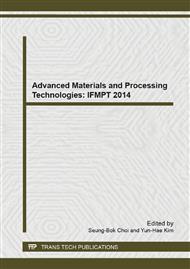p.289
p.293
p.297
p.301
p.306
p.312
p.316
p.320
p.327
Preparation and Characterization of a Novel γ-PGA/β-Tricalcium Phosphate Composite for Tissue Engineering
Abstract:
In order to improvedβ-TCP biocompatibility and cell growth, was chosen to modify β-TCP matrices to produce a γ-PGA/β-TCP composite biomaterial. Then, the morphology, water uptake and retention abilities, in vitro degradation property in the simulated medium, cytotoxicity of this novel γ-PGA/β-TCP composite is investigated. SEM shows that the γ-PGA/β-TCP composite has a porous structure. By increasing the percentage ofγ-PGA from 0% to 50%, the swelling ratio of the composite s was enhanced from 9.0%to 297%. These data suggested that the surface hydrophilicity, water absorption rate, and swelling ratio were improved by adding γ-PGA to the composite. In the cytocompatibility test, the density of MC3T3-E1 preosteoblasts cells on the PTCP1:1 leachates was almost 110% higher than that on the controls on day 3. Therefore, the γ-PGA/β-TCP composite scaffolds, due to their better hydrophilicity, cytocompatibility, and porous structure, are very promising biomaterials for tissure engineering applications.
Info:
Periodical:
Pages:
306-311
Citation:
Online since:
February 2014
Authors:
Price:
Сopyright:
© 2014 Trans Tech Publications Ltd. All Rights Reserved
Share:
Citation:


